Newport Bay is a beautiful natural reserve located in the heart of Southern California, serving as a major attraction for both locals and tourists alike.
Within the area, there is a diverse array of wildlife, with numerous species of birds making their home in the bay. These feathered creatures come in all shapes and sizes, from pelicans with their long beaks to tiny hummingbirds buzzing around the flowers.
The bird population of Newport Bay plays an essential role in the local ecosystem, with some even migrating from far-off locations to take up residence here.
In this article, we will take a closer look at some of the most commonly found birds in Newport Bay, exploring their unique features and behaviors.
1. House Finch

The House Finch is a species of finch native to western North America and has been introduced in the eastern half of the continent as well as Hawaii.
It’s an average-sized finch with adults measuring 12.5 – 15 cm (5 – 6 inches) long and having wingspans between 20 – 25 cm (8 – 10 inches).
The upperparts are brown, while its underparts range from pale grayish white to yellow depending on subspecies.
Its face is streaked or spotted with reddish coloration; males typically have brighter plumage than females due to sexual dimorphism.
They’re mostly found near human habitations such as farms and gardens where they feed on grains, fruits, insects etc., making them very popular among birders who want something colorful for their backyard.Scientific classification:
| Kingdom | Animalia |
| Phylum | Chordata |
| Class | Aves |
| Order | Passeriformes |
| Family | Fringillidae |
| Subfamily | Carduelinae |
| Genus | Haemorhous |
| Species | H. mexicanus |
Also Featured In: Most Common United States Birds, Most Common Winter Birds
2. Mourning Dove

The Mourning Dove is a breathtakingly beautiful bird. It has stunning gray and brown feathers with white tipped wings, giving it an elegant appearance. Its long tail also adds to its graceful look in flight.
A symbol of peace and serenity, they are abundant across North America and can be found in gardens or open fields throughout the year.
As well as being popular game birds for hunters, they feed on grains such as wheat and millet providing important food sources for wildlife species including foxes, coyotes, skunks and raccoons.
These doves have a distinctive cooing sound that can often be heard echoing through woodlands during summer evenings making them one of nature’s greatest treasures.Scientific classification:
| Kingdom | Animalia |
| Phylum | Chordata |
| Class | Aves |
| Order | Columbiformes |
| Family | Columbidae |
| Genus | Zenaida |
| Species | Z. macroura |
Also Featured In: Birds That Live in Colorado, Birds Commonly Found in New York
3. Hummingbirds

Hummingbirds are tiny birds found throughout the Americas, from Alaska to Tierra del Fuego. Most species measure between 3-5 inches in length and weigh less than an ounce.
The smallest hummingbird is only 2 inches long. Hummingbirds have a unique ability of hovering by rapidly flapping their wings up to 80 times per second.
They feed on nectar and insects, with some species even able to drink sap or eat pollen directly off flowers.
Their vibrant colors make them instantly recognizable as they dart through gardens in search of food and mates.
Hummingbirds truly bring joy into our lives as they remind us that nature’s beauty can be seen around every corner if we take the time to look for it.Scientific classification:
| Kingdom | Animalia |
| Phylum | Chordata |
| Class | Aves |
| Order | Apodiformes |
| Family | Trochilidae Vigors, 1825 |
Also Featured In: Birds for Your Home Garden, Famous Paintings Birds
4. American Avocet
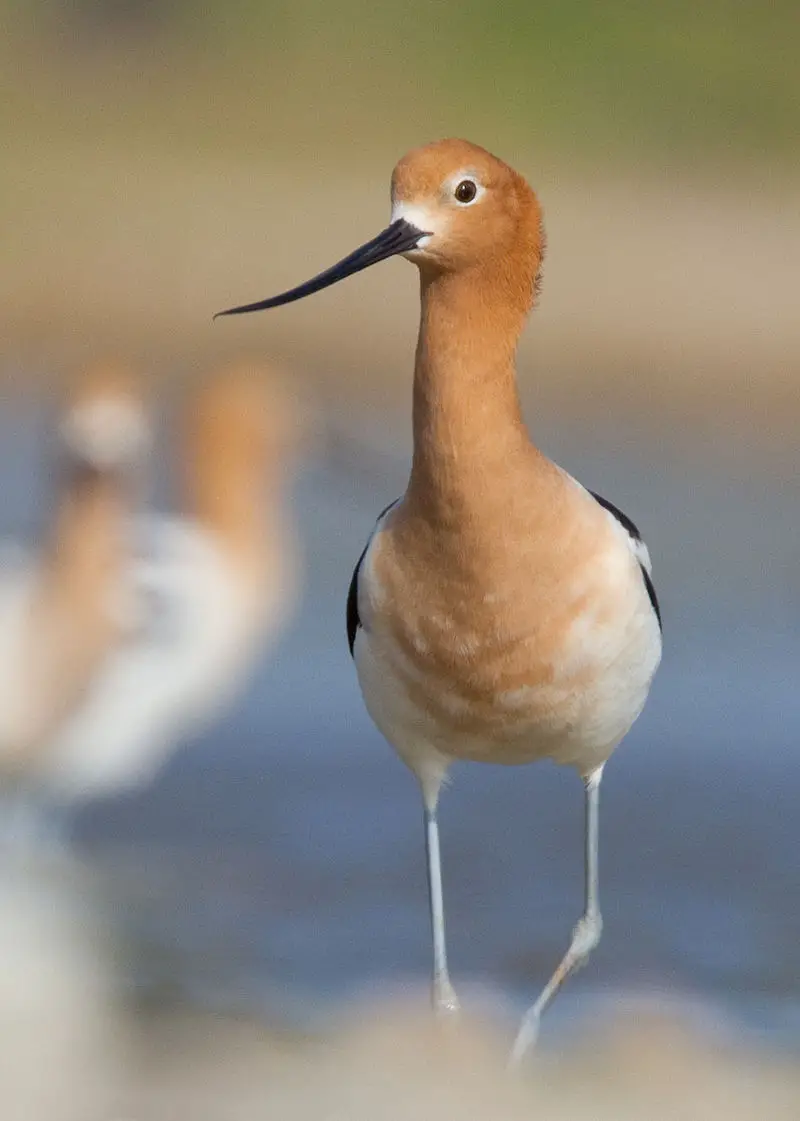
The American avocet is a stunningly beautiful bird found in North America. With its striking black and white plumage, long blue legs, and upturned bill it is an unmistakable sight.
It spends much of its time foraging around shallow water or mud flats searching for crustaceans and insects to feed on by sweeping its beak from side-to-side through the water.
The German naturalist Johann Friedr formally described this species back in 1789 as Recurvirostra americana – aptly named due to their habit of recurving their bills when feeding.
These graceful wading birds are truly a marvel of nature that deserve our admiration.Scientific classification:
| Kingdom | Animalia |
| Phylum | Chordata |
| Class | Aves |
| Order | Charadriiformes |
| Family | Recurvirostridae |
| Genus | Recurvirostra |
| Species | R. americana |
Also Featured In: Most Popular Bird Species in North America, Birds that Live around Central Florida
5. American Coot

The American coot is a bird of the Rallidae family, commonly mistaken for ducks. However, they are only distantly related and have broad lobed scales on their lower legs and toes that fold back with each step to help them walk on dry land unlike ducks which have webbed feet.
Coots are omnivores who typically live in freshwater marshes, ponds and lakes but can also be found in brackish water habitats or even open oceans during migration season.
They feed mainly on algae and aquatic plants as well as small fish, snails, insects larvae and worms from time to time.
The males display territorial behaviour by chasing away intruders within their territory while females lay eggs mostly.
In floating nests made of vegetation near shorelines or islands among reeds where chicks hatch after about three weeks incubation period before swimming off into adulthood shortly afterwards at 10-12 weeks old.Scientific classification:
| Kingdom | Animalia |
| Phylum | Chordata |
| Class | Aves |
| Order | Gruiformes |
| Family | Rallidae |
| Genus | Fulica |
| Species | F. americana |
Also Featured In: Phoenix Birds You Should Know, Long Island Birds You Should Know
6. American Wigeon

The American Wigeon, also known as the Baldpate, is a species of dabbling duck found throughout North America.
It closely resembles its Eurasian counterpart and was formally described in 1789 by German naturalist Johann Friedrich Gmelin.
This medium-sized bird has an overall grey body with white feathers on its face and belly that give it a distinctive bald appearance.
Its wings are brownish black with green speculum markings on them while the tail is dark brown or black at the base and gradually lightens near tips to become chestnut colored.
The male wigeons have purple patches on their heads during breeding season along with yellow eyes which helps differentiate them from females who have duller colors around their faces instead of bright ones like males possess.Scientific classification:
| Kingdom | Animalia |
| Phylum | Chordata |
| Class | Aves |
| Order | Anseriformes |
| Family | Anatidae |
| Genus | Mareca |
| Species | M. americana |
Also Featured In: British Columbian Birds, Estuaries Birds
7. Mallard

The Mallard is a species of dabbling duck that can be found living in temperate and subtropical regions across the Americas, Eurasia and North Africa.
It has been introduced to other areas such as New Zealand, Australia, Peru, Brazil and South Africa by humans.
This beautiful bird belongs to the Anatinae subfamily of waterfowl family Anatidae. The adult mallards have a glossy green head with white neck ring surrounding.
It along with brownish grey body feathers making them look stunning when they fly away or just sitting in their natural habitat around lakes or ponds.
They are excellent swimmers too due to webbed feet which helps them swim fast underwater while looking for food like aquatic insects etc.. Their loud quacking sound makes them quite popular among nature lovers.Scientific classification:
| Kingdom | Animalia |
| Phylum | Chordata |
| Class | Aves |
| Order | Anseriformes |
| Family | Anatidae |
| Genus | Anas |
| Species | A. platyrhynchos |
Also Featured In: Common Birds in the Cities, Most Common Lake Birds
8. Osprey

The Osprey is a majestic bird of prey with an incredibly wide habitat range. It has distinctive brown upperparts and greyish head and underparts, making it easily identifiable in the skies above many regions across the world.
With a wingspan of up to 180cm (71in) and body length reaching 60cm (24in), this large raptor specializes in hunting for fish, soaring high over rivers as well as coasts searching for its next meal.
Despite living near water sources, they can also be found inhabiting mountainsides or even woodlands, proving their incredible adaptability. An impressive species that truly deserves admiration.Scientific classification:
| Kingdom | Animalia |
| Phylum | Chordata |
| Class | Aves |
| Order | Accipitriformes |
| Family | Pandionidae |
| Genus | Pandion |
| Species | P. haliaetus |
Also Featured In: Ukrainian Birds You Should Know, Birds of Sweden
9. Green Heron

The Green Heron (Butorides virescens) is a small heron found throughout North and Central America.
It’s scientific name comes from Middle English ‘butor’ meaning bittern, combined with the Latin term for its distinctive greenish color – ‘virescens’.
For many years it was considered to be part of the same species as the Striated Heron (Butorides striata), commonly referred to as “green-backed herons”.
The nominate subspecies inhabits wetlands across much of this range, where they can be spotted stalking about in shallow water looking for fish or frogs on which to feed.
They are fascinating wading birds that have even been known to use tools such as sticks or baited lines when fishing.Scientific classification:
| Kingdom | Animalia |
| Phylum | Chordata |
| Class | Aves |
| Order | Pelecaniformes |
| Family | Ardeidae |
| Genus | Butorides |
| Species | B. virescens |
Also Featured In: Top Birds Found in Mexico, Birds that You’ll Find in Puerto Rico
10. Marbled Godwit

The Marbled Godwit is a large migratory shorebird in the Scolopacidae family and is one of the largest species amongst four godwits.
It was first described by English naturalist George Edwards in 1750, as ‘The Greater American Godwit’.
The bird has long legs and bill for probing mudflats for food. Their plumage varies from mottled gray to reddish or brown on their upperparts, with white underparts that contrast against it.
During breeding season they can be seen along northern prairies in North America and migrate south towards Mexico during winter months.
They are omnivorous feeders but prefer aquatic insects like crustaceans, larvae etc., which makes them an important element of wetland ecosystems across its range.Scientific classification:
| Kingdom | Animalia |
| Phylum | Chordata |
| Class | Aves |
| Order | Charadriiformes |
| Family | Scolopacidae |
| Genus | Limosa |
| Species | L. fedoa |
Also Featured In: Birds that Live in San Francisco Bay Area, Wetlands Birds You Should Know
11. Little Blue Heron

The Little Blue Heron is a small, darkly-colored heron with two-toned bill. Juveniles are completely white, similar to the Snowy Egret. In breeding season, adults develop unique coloration on their head and legs.
The bird has an expansive habitat range that covers much of the Americas from North America all the way down to South America.
They feed mostly in shallow water areas like tidal flats or marshes and eat small aquatic animals such as fish, frogs and crustaceans.
This species can also be found along coastal regions where they gather at night for roosting purposes during winter months when food sources become more scarce due to migration patterns of its prey animals.
These birds have adapted well over time allowing them to persist in most habitats throughout their wide range even despite environmental changes caused by human activities such as pollution or development projects near wetlands ecosystems which are essential for this species’ survival.Scientific classification:
| Kingdom | Animalia |
| Phylum | Chordata |
| Class | Aves |
| Order | Pelecaniformes |
| Family | Ardeidae |
| Genus | Egretta |
| Species | E. caerulea |
Also Featured In: Blue Birds You’ll Found around Us, Everglades Birds
12. Great Egret

The Great Egret is a large, white bird found in many regions of the world. It has four subspecies that reside across Asia, Africa, Americas and southern Europe.
This species usually lives near bodies of water such as lakes and marshes. They are also now starting to spread into more northern areas of Europe due to climate change.
These birds have long yellow legs with an impressive wingspan for their size which allows them to soar majestically through the sky hunting for fish or amphibians in shallow waters below.
Their feathers have been used historically by Native Americans as part of traditional garments or ceremonies but this practice should be avoided today so these amazing creatures can thrive without harm from humans.Scientific classification:
| Kingdom | Animalia |
| Phylum | Chordata |
| Class | Aves |
| Order | Pelecaniformes |
| Family | Ardeidae |
| Genus | Ardea |
| Species | A. alba |
Also Featured In: Most common Birds in France, Most Common Romanian Birds
13. Great Blue Heron

The Great Blue Heron is a majestic wading bird found in many parts of North America, Central America, the Caribbean and even as far away as the Galapagos Islands.
It has an impressive wingspan which can reach up to six feet wide. Its feathers are mainly bluish-gray with brownish streaks on both its neck and chest while its head displays white plumes.
The adult herons can also be identified by their yellow bill and legs.
They live near bodies of water such as lakes, marshes or rivers where they feed on fish using a spear like motion with their sharp bills.
An all-white population exists only in south Florida and the Florida Keys making it quite unique.Scientific classification:
| Kingdom | Animalia |
| Phylum | Chordata |
| Class | Aves |
| Order | Pelecaniformes |
| Family | Ardeidae |
| Genus | Ardea |
| Species | A. herodias |
Also Featured In: Common Birds in Canada, Birds that Live in the Deserts
14. Black-Crowned Night Heron
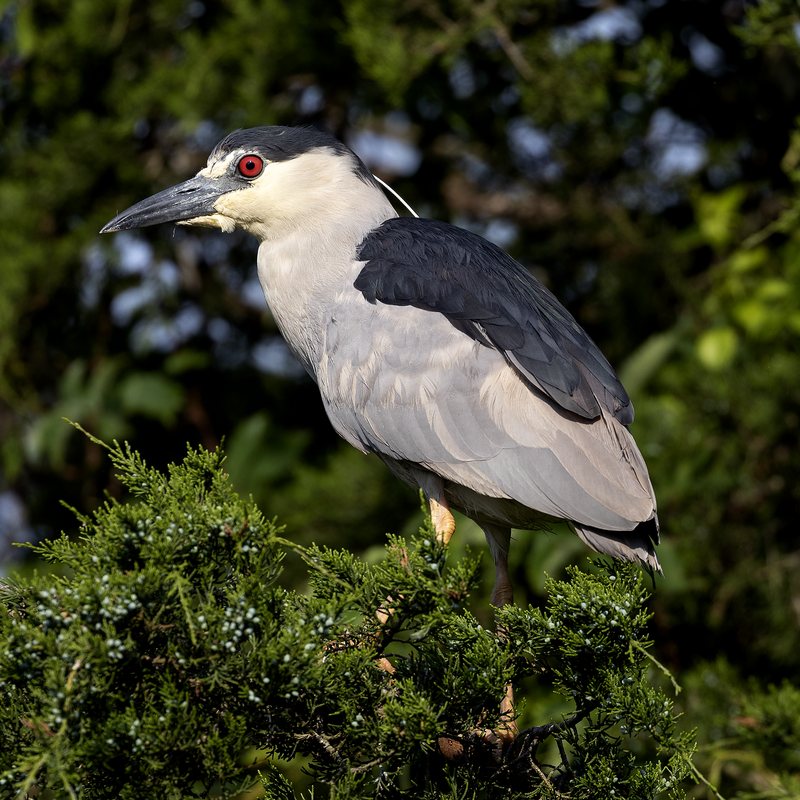
The Black-crowned night heron (Nycticorax nycticorax) is a medium-sized bird found in various parts of the world, including Europe, Asia and North and South America.
It has black crowns on its head with white feathers underneath. Its wings are greyish brown while its underparts are mostly white.
This species can be seen foraging near shallow water or along coastlines during dusk or dawn as it hunts small fish, amphibians and crustaceans.
They also feed on insects such as grasshoppers and beetles which they find in meadows close to freshwater bodies like lakes or ponds where they breed during springtime making nests using twigs lined with reeds and leaves near these waterside habitats.
In Australasia, this species hybridizes with the nankeen night heron that inhabits those areas instead; however both populations remain distinct from each other despite their overlap range regions.Scientific classification:
| Kingdom | Animalia |
| Phylum | Chordata |
| Class | Aves |
| Order | Pelecaniformes |
| Family | Ardeidae |
| Genus | Nycticorax |
| Species | N. nycticorax |
Also Featured In: Common Birds Found in Switzerland, Birds of Kauai, Hawaii
15. Snowy Egret
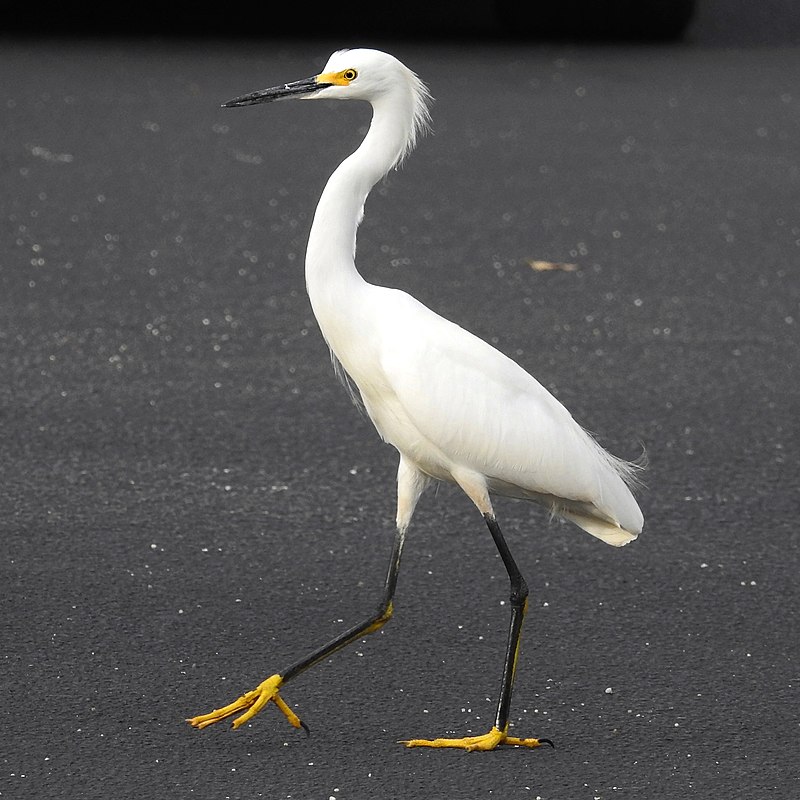
The Snowy Egret is a small white heron native to North America. Its scientific name, Egretta thula, comes from Provençal French for the little egret and an incorrect reference to the Black-necked Swan by Chilean naturalist Juan Ignacio Molina in 1782.
This beautiful bird has black legs with yellow feet, and a long plume of feathers on its head that often appears as if it’s wearing a crown.
It feeds primarily on insects and aquatic life like fish or frogs making it well adapted for both wetland habitats such as marshes or swamps plus coastal areas close to shorelines.
With their graceful movements they are truly delightful creatures to observe while out exploring nature.Scientific classification:
| Kingdom | Animalia |
| Phylum | Chordata |
| Class | Aves |
| Order | Pelecaniformes |
| Family | Ardeidae |
| Genus | Egretta |
| Species | E. thula |
Also Featured In: Trinidad and Tobago birds, Swamps Birds You Should Know
16. Spotted Sandpiper
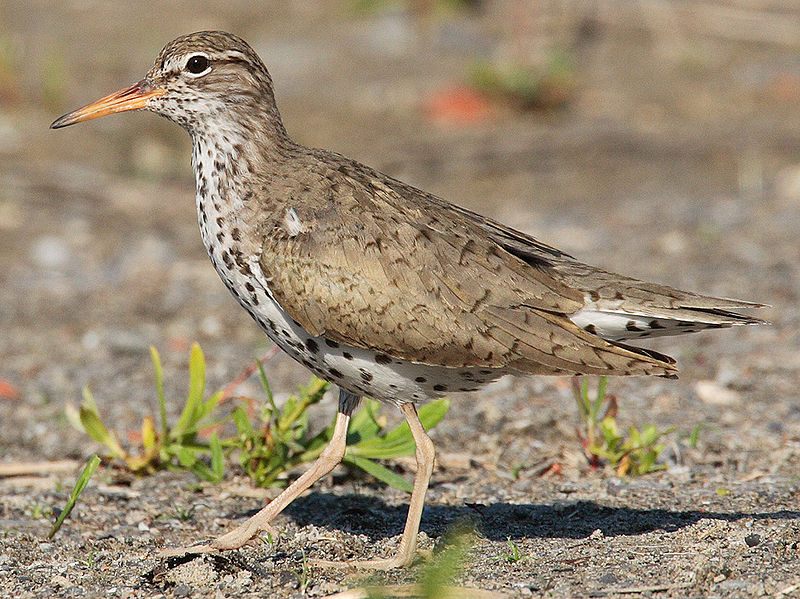
The Spotted sandpiper (Actitis macularius) is a small shorebird that can be found across North America and parts of South America.
It has an appealing spotted plumage, predominately brown in colour with white spots on the wings, tail feathers, head and neck.
The Common Sandpiper (A. hypoleucos) is its sister species which takes over geographically when the other moves away; they have been known to hybridize as well when strays settle down among breeders.
This bird was first described by Carl Linnaeus in 1766 in his twelfth edition of Systema Naturae as a migratory summer visitor to Europe but it now also occupies many habitats too like beaches, riversides and even grasslands during migration periods or for breeding season itself.
Its diet consists mainly of insects such as air-borne flies plus molluscs from shallow water areas – this makes them quite unique amongst waders.Scientific classification:
| Kingdom | Animalia |
| Phylum | Chordata |
| Class | Aves |
| Order | Charadriiformes |
| Family | Scolopacidae |
| Genus | Actitis |
| Species | A. macularius |
Also Featured In: Suriname birds, Common Central Park Birds
17. Yellow-Crowned Night Heron

The Yellow-crowned night heron is a beautiful and unique species of bird native to the Americas. It has distinctive yellow crowns on its head, making it easy to identify among other herons.
These birds are also larger than most other types of herons, reaching up to 70 cm in length and 850 g in weight.
They usually feed on small fish or crustaceans while wading through shallow waters with their long legs.
The yellow-crowned night heron can be found near marshes or lakes during breeding season when they will build nests made from twigs high above the ground for protection against predators like raccoons and foxes.
This majestic bird is an important part of wetland ecosystems as it helps keep populations of smaller aquatic animals balanced by preying upon them.Scientific classification:
| Kingdom | Animalia |
| Phylum | Chordata |
| Class | Aves |
| Order | Pelecaniformes |
| Family | Ardeidae |
| Genus | Nyctanassa |
| Species | N. violacea |
Also Featured In: Bermuda birds, Common Birds of Houston
18. Black Phoebe

The black phoebe is a beautiful passerine bird belonging to the tyrant-flycatcher family. It breeds from southwest Oregon and California south through Central and South America, where it can be found year-round.
However, its northern populations tend to migrate seasonally in some areas. Six subspecies of this species have been identified so far: two are occasional visitors while the others are more common residents in their range.
The adult has mainly dark grey upperparts with a white belly; juveniles may show brownish tones instead of grey ones on their back.
Its main diet consists of insects which it catches by hovering over water or flying out after them from perches near rivers or streams – hence why they’re often seen around these places.Scientific classification:
| Kingdom | Animalia |
| Phylum | Chordata |
| Class | Aves |
| Order | Passeriformes |
| Family | Tyrannidae |
| Genus | Sayornis |
| Species | S. nigricans |
Also Featured In: Flycatchers Species, Birds Live Near San Diego
19. Western Gull

The Western Gull is a majestic seabird found on the West Coast of North America, ranging from British Columbia to Baja California. It has a large white head and stands between 22-27 inches in size.
Its upper parts are gray while its underparts range from brownish grey to white depending on age or sex of the bird.
The most distinguishing feature is its yellow feet which set it apart from other gulls in the area such as Larus livens.
These birds feed by scavenging for food including fish, mollusks, crustaceans and even carrion when available.
They also nest near ocean shores with their eggs hatching anywhere within 28 days after being laid. A beautiful sight to behold at any beach; these birds will surely captivate you with their grandeur.Scientific classification:
| Kingdom | Animalia |
| Phylum | Chordata |
| Class | Aves |
| Order | Charadriiformes |
| Family | Laridae |
| Genus | Larus |
| Species | L. occidentalis |
Also Featured In: Gulls Species, Birds that Live in the Ocean
20. Double-Crested Cormorant
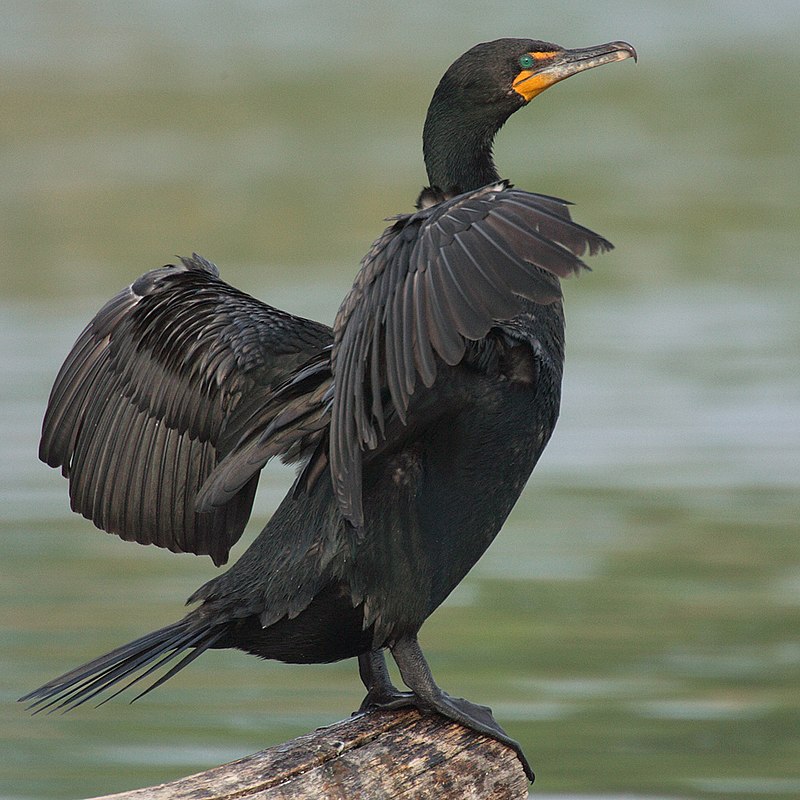
The double-crested cormorant is a majestic bird with an impressive wingspan, found across North America from the Aleutian Islands all the way down to Mexico.
Its black plumage stands out against its bright orange-yellow facial skin and some extended patches of white feathers on each side of its throat.
It measures between 28 – 35 inches in length and has webbed feet that enable it to swim gracefully through rivers and lakes, as well as coastal areas.
These birds are known for their voracious appetite for fish, sometimes diving over 100 ft deep into water looking for food.
Despite this reputation they also feed on crustaceans, amphibians and insects when available.
Cormorants have been part of many cultures throughout history due to their remarkable ability to fly long distances making them valued messengers or companions during fishing expeditions at sea.Scientific classification:
| Kingdom | Animalia |
| Phylum | Chordata |
| Class | Aves |
| Order | Suliformes |
| Family | Phalacrocoracidae |
| Genus | Nannopterum |
| Species | N. auritum |
Also Featured In: Cormorant Species, Water Birds Live around Us
21. White-Crowned Sparrow

The White-crowned Sparrow is a species of passerine bird native to North America. It has a grey face and black and white streaking on its upper head, making it easy to identify.
This sparrow usually breeds in brushy areas located in the taiga, tundra, Rocky Mountains or Pacific coast regions of North America.
During winter months these birds migrate southward as far as Mexico and California where they can be found living amongst chaparral shrubbery or low bushes near open fields with plenty of seeds nearby.
The diet of this bird consists mainly of insects during summer while they switch over to eating grains like wheat & oats during colder months when bugs are scarce.
They are known for their characteristic chirp which sounds like “Oh sweet Canada Canada” drawing admirers from around the world.Scientific classification:
| Kingdom | Animalia |
| Phylum | Chordata |
| Class | Aves |
| Order | Passeriformes |
| Family | Passerellidae |
| Genus | Zonotrichia |
| Species | Z. leucophrys |
Also Featured In: Sparrows Species, Most Common Songs Birds that Live around You
22. Willet

The Willet is a large and robust bird of the Scolopacidae family. It belongs to genus Tringa and it is much larger than its closest relative – lesser yellowlegs, which can be easily distinguished by its fine neck pattern.
The willet has brown upperparts with white patches on wings along with grey underparts. Its bill is thick, long and straight in shape having black coloration at tip while legs are also long but greenish-grey in colour.
They feed mainly on insects, worms or crustaceans that they find near coastal waters or wetlands as well as grains or seeds when available during winters.Scientific classification:
| Kingdom | Animalia |
| Phylum | Chordata |
| Class | Aves |
| Order | Charadriiformes |
| Family | Scolopacidae |
| Genus | Tringa |
| Species | T. semipalmata |
Also Featured In: birds of Delaware, Birds that can be Seen in Outer Banks
23. Sandpiper

Sandpiper is a type of wading bird that belongs to the family Scolopacidae. It is a diverse family that includes various species such as curlew and snipe.
Sandpipers have different bill lengths that allow them to feed on small invertebrates and creatures found in mud or soil.
Due to this diversity, different species can coexist in the same habitat without competing for food.
Sandpipers are commonly found near the coast but are also found in other wetland environments.
They are known for their slender legs, long beak, and streamlined body that enables them to move easily in and out of water.
Sandpipers are a unique and fascinating bird species that are interesting to observe in their natural habitat.Scientific classification:
| Kingdom | Animalia |
| Phylum | Chordata |
| Class | Aves |
| Order | Charadriiformes |
| Suborder | Scolopaci |
| Family | Scolopacidae Rafinesque, 1815 |
Also Featured In: Birds You’ll Find in the Sea, Turkey Birds You Should Know
24. Brown Pelican

The majestic brown pelican is a dive-feeding bird that belongs to the pelican family. It is one of the three pelican species found in the Americas and is known to dive into water to catch its prey.
From the Atlantic Coast of New Jersey to the mouth of the Amazon River, and along the Pacific Coast from British Columbia to northern Chile, including the Galapagos Islands, this bird can be found.
Its scientific name is Pelecanus occidentalis, and it has a colored brown plumage, which is its distinct characteristic.
The brown pelican belongs to the largest bird species that exist today, with a wingspan that can stretch up to seven feet long.
This bird helps maintain a balance in the ecosystem by eating smaller fish, crustaceans, and other aquatic prey.Scientific classification:
| Kingdom | Animalia |
| Phylum | Chordata |
| Class | Aves |
| Order | Pelecaniformes |
| Family | Pelecanidae |
| Genus | Pelecanus |
| Species | P. occidentalis |
Also Featured In: Flight Birds You Should Know, Common Southern Californian Birds